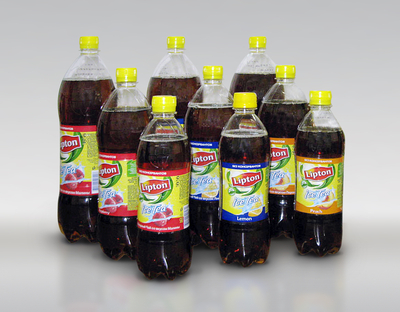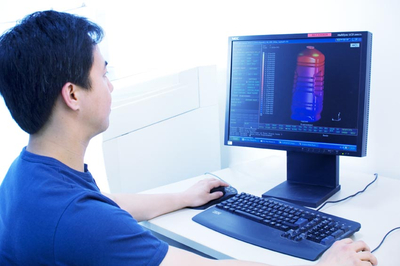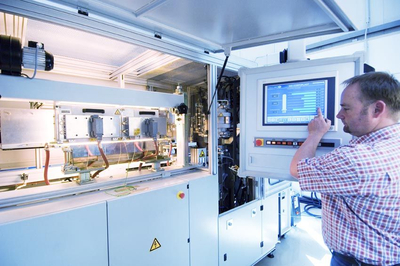
Bottles & Shapes™ Provides Added Value Right Down The Line
Practical example: development of a new Lipton iced tea, hotfill PET bottle for the Pepsi Bottling Group
Matthias Gernhuber*
Bottles & Shapes™ is the name of the internationally unique service and consultancy program from KHS Corpoplast for the design and development of plastic bottles. KHS Corpoplast falls back on over 35 years of experience in stretch blow molding and PET process technology and thus has a wealth of expertise in this field. Within the Bottles & Shapes™ program, KHS Corpoplast acts as a constant partner to companies in the food and non-food industries throughout the entire development of a plastic container – from the initial idea to its industrial manufacture. At all times there is extremely close collaboration with the Marketing and Engineering departments of the company to be advised. During each stage in the design of the container, the ecological, economical, and functional aspects of the packaging also undergo close scrutiny. The aim of the Bottles & Shapes™ program is always to create a container that fully meets marketing demands and is of the highest quality, while keeping costs to a minimum and ensuring sustainability throughout the entire production process. And of course, the plastic packaging always has to be premium. The optimum production of this premium plastic packaging is guaranteed not least by the use of InnoPET Blomax stretch blow molders from KHS Corpoplast, plant engineering that is not only setting standards in cost efficiency but also with regard to the precision of the plastic bottles produced with its outstanding process accuracy. In order to show just how much added value Bottles & Shapes™ can offer in a specific case, by way of example we shall now study the various stages in the program recently implemented at the Pepsi Bottling Group. The task here was to develop a new premium PET bottle for Lipton iced tea in 0.6, 1.0 and 1.5-liter sizes in accordance with a given, typical brand design while ensuring optimum functionality and minimized overall costs.
*Product Manager, Bottles & Shapes™, KHS Corpoplast GmbH & Co. KG, Hamburg, Tel: +49 (40) 67907-442
Question one: which filling technology for which product?
The first question always asked when the Bottles & Shapes™ program comes into play is: which products are to be filled in the resulting plastic bottle and which filling technology is to be used? The first stage also involves clarifying which other requirements will be made of the bottle to be manufactured such as the stress the plastic bottle is subjected to while being conveyed through the line and up to and including the palletizing process, and also during shipment to markets and points of sale.
The task: to hot fill PET bottles without vacuum compensation panels
In Pepsi's case, the task was to hot fill Lipton iced tea in a PET bottle with an exact visual appearance stipulated by the company. At first this seemed impossible; in order to ensure that they were suitable for hot filling, PET bottles to date have had to be equipped with vacuum compensation panels that made specific contours in the bottle shape necessary. The reason for this is that when hot product enters the PET bottle and cools, a vacuum is created. This vacuum usually causes the PET bottle to contract and shrink. Vacuum compensation panels prevent shrinking and maintain the shape stability of the PET bottle. However, these panels rather limit creativity when it comes to bottle design.
The solution: nitrogen flushing of freshly filled PET bottles
KHS Corpoplast then began looking for a way of enabling the specific PET bottles prescribed by Pepsi to be hot filled. The ingenious solution they came up with was HotFill+, an innovative method of hot filling in which no vacuum is created in the PET bottle thereby eliminating the need for vacuum compensation panels. Applying HotFill+ meant that the Lipton iced tea bottle could now be developed in full accordance with Pepsi's requirements.
The entire beverage industry will profit
In developing this process, KHS Corpoplast once again made the virtually impossible possible – totally in the interests of the Pepsi Bottling Group. As with the results of any new research project, the entire beverage industry is set to profit to a large degree, with hotfill bottles now able to enjoy total freedom of design.
The beverage sector will also benefit from another new development that is being applied to the Lipton iced tea bottle at Pepsi for the first time. Pepsi specifications were for premium PET bottle quality coupled with a reduction in overall costs – and the highest possible stretch blow molder output capacity.
Since the chief way of noticeably cutting costs in manufacturing PET bottles is to reduce outlays for materials, KHS Corpoplast endeavored to considerably reduce the weight of the 0.6, 1.0 and 1.5-liter Lipton iced tea bottles. This reduction in expenditure for materials proved even more advantageous than originally thought; laboratory tests showed that it was not only possible to eliminate the need for vacuum compensation panels but also that the manufacturing process for the Lipton iced tea PET bottles could be optimized even further.
Development of an optimized manufacturing process for savings in energy and compressed air
The specific target of further process optimization was the blow process. Thermally induced crystallization in the PET material (to make the PET thermally resistant) and relaxing (to reduce tension) during the PET hotfill bottle blow molding process have been common practice to date. In order to thermally crystallize the PET, the blow molds usually have to be heated to temperatures of between 130 and 165°C. Filling tests on PET bottles produced for Lipton iced tea showed that at the temperature required for filling this particular product it is sufficient to rely on the relaxation effect of the PET during stretch blow molding and dispense with thermally induced crystallinity. This means that the blow molds only have to be heated to a temperature of 115°C during stretch blow molding, thus achieving considerable savings in energy. Another bonus in this context is that if only the relaxation process is used, there is no need to purge the insides of the bottles with cold air after stretch blow molding, as the shape of the PET bottles is stable thanks to the lower temperature used during blow molding. Simply by omitting this stage in the process, up to 60% compressed air is saved compared to the amounts needed in the manufacture of conventional hotfill PET bottles.
Simplified blow molding and a higher bottle output
Simplifying the stretch blow molding process for hotfill PET bottles destined for Lipton iced tea also helps to increase performance versus classic stretch blow molding. Where previously 1,200 to 1,400 hotfill PET bottles could be made an hour per blow station, using the new method of production this number increases to up to 1,800 per hour and blow station. Compared to the classic stretch blow molding process for hotfill PET bottles, this is an increase in production of up to 50%.
Significant saving in material costs
The simplified stretch blow molding process plus doing without vacuum compensation panels on the PET bottles results in a reduction in weight of between 7% and 25%, depending on the bottle size.
The pilot project for the manufacture of newly developed PET bottles and the filling of Lipton iced tea therein was launched at the Pepsi Bottling Group in Russia where an InnoPET Blomax 24 CHR stretch blow molder with 24 blow stations makes the new hotfill bottles. Taking the manufacture of the 0.6-liter PET bottle for Lipton iced tea as an example, the stretch blow molder produces 43,200 0.6-liter PET bottles an hour – resulting in an annual saving in costs for PET of several thousand euros.
The Bottles & Shapes™ program – always identical and yet completely individual
The given data and newly developed manufacturing technologies are all the result of the Bottles & Shapes™ concept that is carefully planned right down to the last detail. In the Bottles & Shapes™ program, the process is always identical but carefully selected so that it allows maximum individuality. Once the question of packaging, product, and the expected forms of stress exerted on the container have been clarified, as mentioned in the above, KHS Corpoplast then suggests designs for all kinds of plastic bottle on request in close negotiation with the client company. These suggestions are geared towards market conditions and assessed for technical feasibility.
Computer simulation of PET bottles using finite element analysis
The shape of the container is developed using computer simulation. In finite element analysis, all known influences, such as stress and vacuum tension caused by excessive pressure, for example, are simulated and applied to the virtual packaging. The data on the system can be varied at any time which saves time and permits new settings to be made quickly. At Pepsi, computer simulation was a major component of the bottle design. Here, it was important to simulate and neutralize the vacuum tension for the given PET bottle sizes.
Saving time and money with rapid prototyping
If the features of the PET container generated by computer simulation meet customer requirements, KHS Corpoplast can produce prototypes of the new packaging within a very short space of time. Both plaster and plastic casts are available within just a few hours. Unlike virtual 3D design on screen, models give customers the chance to see their PET container for real before it goes into production. Its shape and form can be felt and its optical design is more detailed and better perceivable than when only seen on the computer screen. At the same time, through the fast production of a prototype no time is lost that could be detrimental to the launch to market.
Laboratory testing – putting bottles through their paces
The next stage in the Bottles & Shapes™ program is to make PET bottles on a laboratory machine. This lab setup works just like the stretch blow molders later used in practice. Efficiency, blow molding pressures, and the temperature profile used to heat the PET preforms and blow molds can all be demonstrated on the laboratory machine like on any KHS Corpoplast stretch blow molder. All process-relevant settings can thus be realized. The blow molds used on the lab machine are made by KHS Moldtec – as they are for the stretch blow molder that will later be in operation. This makes everything available from a one-stop shop – yet another major advantage for the customer. What's more, KHS Moldtec has a mine of experience that is practically untoppable! Over 4,000 different blow molds are made here each year. Besides stretch blow molding, the KHS Corpoplast laboratory also simulates the ensuing filling process in full accordance with practical specifications.
In the case of the Lipton iced tea bottle, the lab tests were primarily to determine whether the relaxation process alone could meet the given hotfill conditions in the manufacture of PET bottles. Researchers also examined whether the bottle design had to be modified in order to neutralize the presence of vacuum.
Sample containers for the first practice run
Only when test results confirm all given specifications does the certified KHS Corpoplast laboratory approve the plastic container for production. This is usually followed by tests in practice. KHS Corpoplast provides the necessary plastic sample packaging for market testing, filling tests, and labeling, packaging, and palletizing tests. Pepsi also ordered sample bottles that were rigorously put through their paces. The result was that production went just as KHS Corpoplast had forecast.
In all test results, KHS Corpoplast emphasizes that numerous features, such as ultra lightweighting, require the highest accuracy of process repeatability. InnoPET Blomax stretch blow molders from KHS Corpoplast not only have an excellent record of efficiency and availability; they are also leaders when it comes to process precision, underlined by the precision mandrel guidance of the preforms, a minimum pitch and thus best heat penetration of the preforms; they have the best values when it comes to repetition of the stretch blow molding process and distribution of materials and extremely fast switching blow valves with lowest possible dead air volume.
The result is top quality
The Bottles & Shapes™ program offers the companies it services a well-founded, efficient source of expert knowledge. It covers everything, from the first ideas for the design and marketing of the prospective container to CAD bottle design and development; from preform and blow mold specifications to the industrial manufacture of the PET bottles. The program creates plenty of impressive added value for beverage companies that pays off in a number of different respects. Yet when it comes down to it, all arguments in favor of the Bottles & Shapes™ program have one central message: Bottles & Shapes™ is about optimum quality – and about premium plastic bottles.



